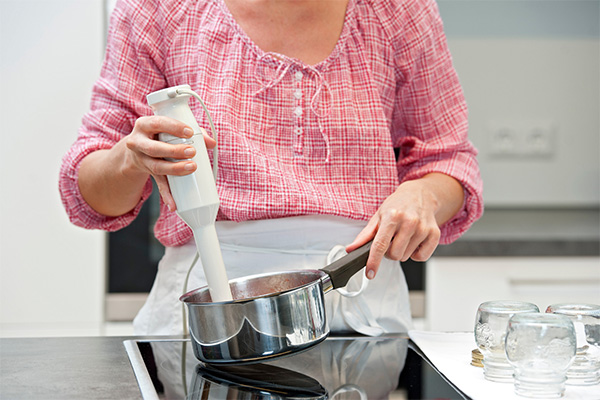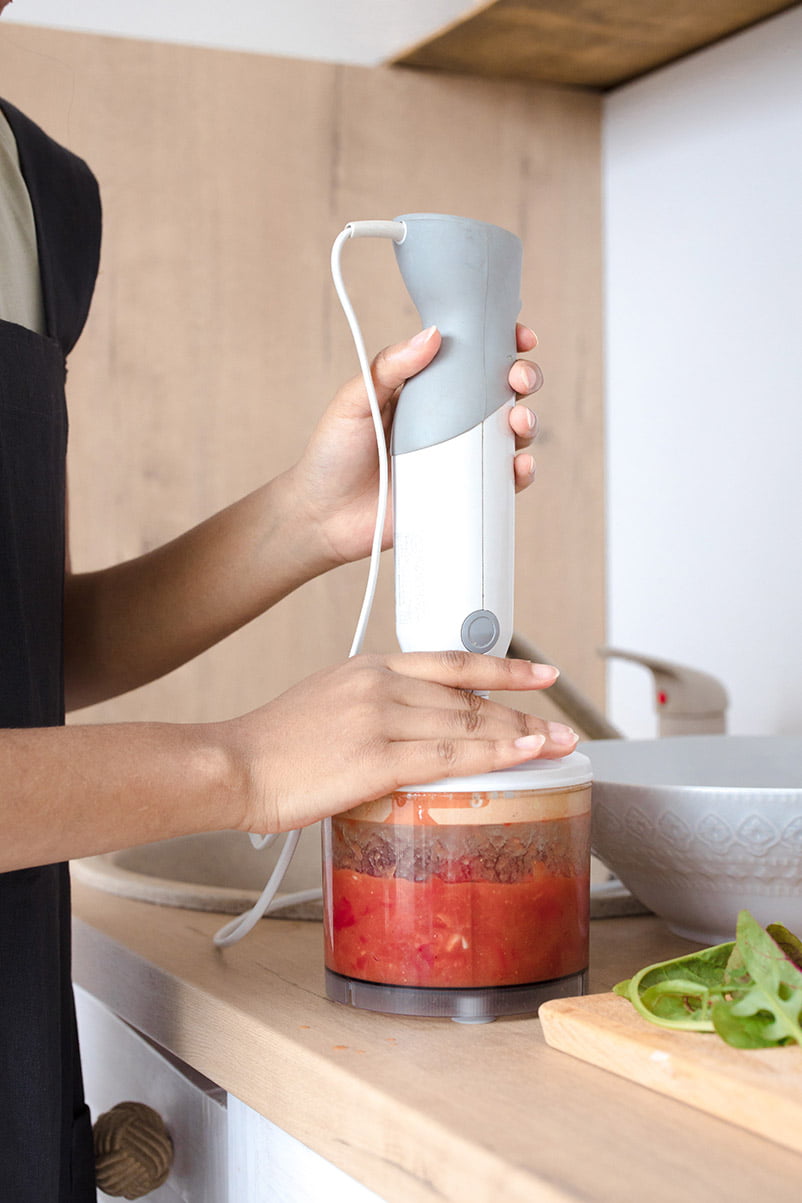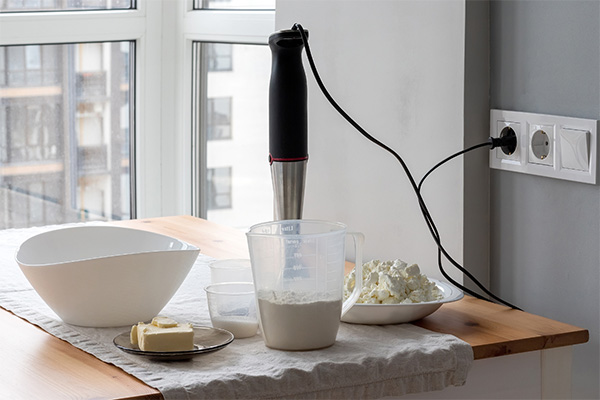Many valuable kitchen tools get swept under the radar in a world filled with kitchen appliances. Don't let an immersion blender be one of them! This handheld blender can replace an electric whisk mixer, a mini food processor, and a standard blender - and takes no more space in your drawer than a couple of spoons. Keep reading to learn what an immersion blender is and why your kitchen will benefit from this tool!
What Is An Immersion Blender?
An immersion blender, hand blender, or stick blender is designed for the modern cook who values both efficiency and versatility in their culinary tools. Picture a slender, handheld device, elegantly elongated, with a motor housed in its ergonomic handle that connects to a narrow blending shaft. At the end of this shaft, concealed by a protective guard, lies a powerful set of stainless steel blender blades, ready to transform ingredients with a button. This device is not just a blender; it's a magic wand for your kitchen, allowing you to blend, mix, and puree directly in the pot, pan, or bowl, eliminating the need for transferring hot soups or sauces into a countertop blender.
The immersion blender is celebrated for its ability to perform various culinary tasks. Its versatility is unmatched, from whipping up smooth consistency soup to achieving creamy consistency sauces, emulsifying dressings, or even making homemade whipped cream. It's particularly favored for its convenience in preparing smoothies, milkshakes, or blending ingredients for baking, offering a level of control and precision that other kitchen appliances simply cannot.
The immersion blender's design is not just about functionality but also simplicity and ease. With a detachable shaft for easy cleaning—often dishwasher safe—cleanup becomes a breeze, making it an indispensable tool for both seasoned chefs and kitchen novices alike. Its compact size ensures it can be easily stored or displayed, requiring minimal space yet always ready to assist in your next culinary adventure. Whether you're a passionate home cook or a professional chef, the immersion blender is a testament to modern kitchen efficiency, blending innovation with the art of cooking.
Immersion Blender Versus Countertop Blender
The primary difference between an immersion blender and a countertop blender is what you do with the ingredients you need to blend. A countertop blender includes a large jar that sits on a motorized base that spins the blades. To use it, you need to fill the jar with the ingredients.
On the other hand, an immersion blender doesn't include any sort of jar or canister. Instead, you place the stick blender directly into the pot or jar, which is already holding the ingredients.
In short, you bring the immersion blender to the food, and you bring the food to the countertop blender.
How Does An Immersion Blender Work

The key to immersion blender operation lies in the sharp, stainless steel blades that create a vortex, a circular flow that effectively draws ingredients towards the blades for thorough blending. The rotating blades' shearing and cutting action breaks down solids into smaller particles, mixes them uniformly with liquids, and can incorporate air into the mixture, which is useful for creating emulsions or whipping creams.
One of the primary advantages of an immersion blender is its ability to blend ingredients directly in the pot, bowl, or glass in which they are being prepared. This allows for the blending of hot ingredients directly on the stove and significantly reduces cleanup by minimizing the number of dishes used.
The immersion blender stands out for its versatility, being suitable for a wide range of tasks, from blending soups (like lentil soup) and sauces to whipping cream and making smoothies. Its convenience is further highlighted by its easy cleanup, with many models featuring detachable blending shafts that are dishwasher safe, and its compact size, which makes it a space-saving tool ideal for kitchens with limited storage space. Through its efficient blending mechanism and user-friendly design, the immersion blender offers a practical solution for various kitchen tasks, combining precision with ease of use.
Benefits Of An Immersion Blender

Easy Cleanup
All the immersion blenders make for easy cleanup in two ways. First, there's no need to dirty up another dish! For example, you can place your immersion blender directly into the pot if you need to puree a hot soup. You don't need to transfer those hot ingredients into a traditional blender jar and wash up the jar afterward. Secondly, cleaning a hand blender is as easy as detaching the wand and rinsing the attachment and the blades under running water.
Convenience
Immersion blenders are incredibly convenient to use. They're handheld and easy to maneuver, which makes them perfect for blending directly in pots, bowls, or containers. Transferring hot liquids or ingredients to a separate blender is unnecessary.
Unlimited Capacity
Since there is no blender jar to fill, you can use your handheld immersion blender to easily tackle whole pots of food! The jar capacity does not limit you unless you use a blending jar. On the other end of the spectrum, no quantity of food is too small. Traditional blenders often struggle to blend small amounts of food thoroughly. An immersion blender, however, can easily handle small batches of salad dressing or chopping a handful of nuts.
Space-Saving
An immersion blender takes up little space in a drawer and absolutely zero real estate on your kitchen counter.
Cordless Availability
If you are short on electrical outlets in your kitchen or would rather not be tethered by a cord, no problem! Many manufacturers offer a cordless immersion blender model. These blenders feature a rechargeable battery, allowing you to move about your cooking space easily.
Variable Speeds
Like your regular blender, many immersion blender models have multiple speed settings. Low-speed settings are perfect for liquid uses, such as frothing milk or mixing batters. Higher speed settings can turn vegetable chunks into pureed soups, fibrous vegetables into creamy smoothies, and hard nuts into delicious nut butter.
Versatile Attachments
Hand blenders come standard with a food processor attachment. However, multiple attachments are available to switch out and expand its use! Try a whisk attachment, and you can put your electric mixer to rest. Use a chopper attachment for mincing vegetables or crushing ice.
Limited Functionality
While immersion blenders are excellent for blending and pureeing, they might not be suitable for tasks that require more complex processing, such as chopping, slicing, or grating. For these tasks, you'd need separate kitchen appliances.
Splattering
Immersion blenders can create splatters and messes, especially when blending at high speeds or working with thin liquids. This can make cleanup more time-consuming, as you'll need to wipe down surfaces and possibly even yourself.
Risk Of Scratching Cookware
If you're blending in a pot or container with a non-stick or delicate surface, the metal blades of the immersion blender could potentially scratch or damage the coating.
Noise
While immersion blenders are generally quieter than countertop blenders, they can still produce a noticeable amount of noise, which might be disruptive in a quiet kitchen environment.
Heat Sensitivity
Some immersion blenders struggle with high heat. If you're blending hot soups or sauces, the heat can affect the blender's motor, or steam release could cause splattering.
Motor Heat
If you use an immersion blender for an extended period, the motor can heat up, potentially leading to overheating. This might require you to pause and let the blender cool down before continuing.
Drawbacks Of An Immersion Blender

Small Batches
If you use an immersion blending jar, you could be limited to capacity. Immersion blenders are generally designed for small to medium-sized batches like making toum and hummus. If you're working with many ingredients, you might need to blend in multiple batches, which can be time-consuming and less efficient. You can also try to blend the ingredients directly in a pot or a bowl.
Less Powerful
Unlike countertop blenders or food processors, immersion blenders often have less powerful motors. This can make it challenging to blend tougher or larger pieces of ingredients or break down ice cubes, resulting in uneven blending or even damage to the blender's motor over time.
What Can You Make Using An Immersion Blender
Smoothies and Shakes: Blend together a variety of fruits, such as bananas, berries, and mangoes, with yogurt, milk, or juice to create delicious and nutritious smoothies and shakes. Depending on the immersion blender, you can even make delicious smoothies using frozen fruit or vegetables.
Soups and Sauces: Immersion blenders are a game-changer for soups. After cooking your soup ingredients, you can use the blender directly in the pot to achieve a smooth and consistent texture. This is especially handy for creamy soups like tomato soup or butternut squash soup. Similarly, blend cooked tomatoes, herbs, and cream to create sauces like marinara or Alfredo.
Salsas and Dips: Make vibrant salsas by blending tomatoes, onions, peppers, and cilantro to your preferred consistency. For dips like guacamole or hummus, blend avocados or chickpeas with spices, herbs, and lemon juice.
Salad Dressings: Immersion blenders are excellent for emulsifying ingredients in salad dressings. Combine olive oil, vinegar, mustard, honey, and other flavorings for your own homemade dressings.
Baby Food: Create nutritious baby food by blending steamed or boiled fruits and vegetables like carrots, peas, and apples. The immersion blender ensures a smooth texture suitable for babies.
Mayonnaise: Making homemade mayonnaise from scratch is a breeze with an immersion blender. Blend eggs, oil, vinegar, and seasonings until a thick, creamy mayo forms.
Pancake and Waffle Batter: Achieve a lump-free batter by blending your pancake or waffle ingredients together, resulting in light and fluffy breakfast treats.
Whipped Cream: Blend heavy cream with sugar until soft peaks form, resulting in homemade whipped cream to top desserts and beverages.
Mashed Potatoes: Blend boiled potatoes with butter, milk, and seasoning in an immersion blender to create velvety mashed potatoes.
Cauliflower Rice: Blend cooked cauliflower until it reaches a rice-like consistency, perfect for a low-carb alternative to rice.
Smooth Sauces: Use the immersion blender directly in the cooking pot to achieve a silky-smooth texture in sauces like tomato sauce, cheese sauce, and gravy.
Cocktails: Blend ingredients like fresh fruits, ice, and alcohol to create consistent and well-mixed cocktails.
Pesto: Combine fresh basil, pine nuts, garlic, Parmesan cheese, and olive oil for a flavorful homemade pesto sauce.
Nut Butter: While immersion blenders may not be as powerful as dedicated nut butter machines, they can help you make small batches of nut butter by blending roasted nuts with a bit of oil until smooth.
Fruit Compotes: Blend cooked fruits like berries or stone fruits with sweeteners to make delicious fruit compotes for topping desserts or breakfast items.
Whipped Potatoes: Create fluffy whipped potatoes by blending boiled potatoes with butter, cream, and seasonings, resulting in a light and airy side dish.
Dressings and Marinades: Blend herbs, spices, oil, vinegar, and other ingredients for flavorful dressings and marinades that evenly coat your dishes.
Sauces for Desserts: Make fruit sauces by blending cooked fruits with sweeteners, adding flavor to desserts like ice cream, cheesecakes, and pancakes.
Batters for Baking: Prepare batters for muffins, cakes, and quick bread with your immersion blender, ensuring a consistent mixture.
Hot Chocolate: Blend melted chocolate, milk, and other ingredients to create a rich and velvety homemade hot chocolate.
Fluffy Eggs: With an immersion blender, you can make lighter and fluffier scrambled eggs than ever.
